| Article ID | Journal | Published Year | Pages | File Type |
|---|---|---|---|---|
| 4464821 | International Journal of Applied Earth Observation and Geoinformation | 2013 | 9 Pages |
•We extracted oilseed rape planting area from hyperspectral image by MRSFF.•The variance coefficient weight method was introduced.•Criteria for wavelength range and weight definition was set up.•Result of MRSFF was considerable and robust with less RMSE.•The result indicated critical period for applied remote sensing in agriculture.
Spectral feature fitting (SFF) is a commonly used strategy for hyperspectral imagery analysis to discriminate ground targets. Compared to other image analysis techniques, SFF does not secure higher accuracy in extracting image information in all circumstances. Multi range spectral feature fitting (MRSFF) from ENVI software allows user to focus on those interesting spectral features to yield better performance. Thus spectral wavelength ranges and their corresponding weights must be determined. The purpose of this article is to demonstrate the performance of MRSFF in oilseed rape planting area extraction. A practical method for defining the weighted values, the variance coefficient weight method, was proposed to set up criterion. Oilseed rape field canopy spectra from the whole growth stage were collected prior to investigating its phenological varieties; oilseed rape endmember spectra were extracted from the Hyperion image as identifying samples to be used in analyzing the oilseed rape field. Wavelength range divisions were determined by the difference between field-measured spectra and image spectra, and image spectral variance coefficient weights for each wavelength range were calculated corresponding to field-measured spectra from the closest date. By using MRSFF, wavelength ranges were classified to characterize the target's spectral features without compromising spectral profile's entirety. The analysis was substantially successful in extracting oilseed rape planting areas (RMSE ≤ 0.06), and the RMSE histogram indicated a superior result compared to a conventional SFF. Accuracy assessment was based on the mapping result compared with spectral angle mapping (SAM) and the normalized difference vegetation index (NDVI). The MRSFF yielded a robust, convincible result and, therefore, may further the use of hyperspectral imagery in precision agriculture.
